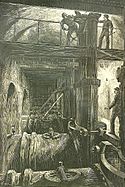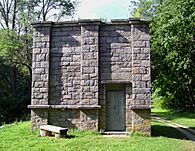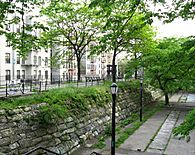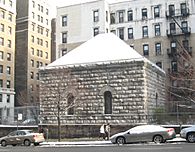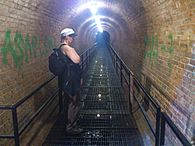Croton Aqueduct facts for kids
|
Old Croton Aqueduct
|
|

Ventilator No. 16, Irvington, New York
(May 2005) |
|
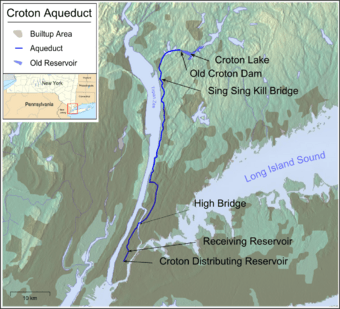
Location of Croton Aqueduct
|
|
| Nearest city | New York City, New York |
|---|---|
| Built | 1837–1842 |
| Architect | John B. Jervis; David Douglass; James Renwick, Jr. |
| NRHP reference No. | 74001324 |
Quick facts for kids Significant dates |
|
| Added to NRHP | December 2, 1974 |
| Designated NHL | April 27, 1992 |
The Old Croton Aqueduct was a huge and clever system built to bring fresh water to New York City. It was constructed between 1837 and 1842. This amazing structure was one of the first of its kind in the United States. It used gravity to carry water 41 miles (66 km) from the Croton River in Westchester County all the way to large storage tanks (called reservoirs) in Manhattan.
The aqueduct was built because New York City's local water sources were getting dirty. Also, there wasn't enough water for the city's fast-growing population. Even though a newer aqueduct, the New Croton Aqueduct, was built in 1890, the Old Croton Aqueduct kept working until 1955.
Contents
Why New York City Needed Water
New York City is on an island called Manhattan. It's surrounded by salty rivers, so getting fresh water was always a challenge. As the city grew quickly after the American Revolutionary War, the few fresh water sources became polluted. This meant the water was no longer safe to drink.
Before the aqueduct, people got water from wells, natural springs, or collected rainwater in tanks called cisterns. But as more people moved to Manhattan, these local water sources became even more polluted. Some wealthy people had water delivered, but most relied on unsafe well water.
Dirty water led to many health problems. Diseases spread easily, and many people became sick. In the 1830s, a lot of people died because of these unhealthy conditions. It became clear that New York City desperately needed a new, clean supply of fresh water.
Building the Aqueduct

In 1833, an engineering professor named Major David Bates Douglass was asked to plan the route for the new water system. Then, in 1837, the huge construction project began. It was led by Chief Engineer John B. Jervis, who took over from Douglass.
Workers built a dam on the Croton River to collect water. They dug tunnels and laid pipes to create the aqueduct. The system was designed to use gravity to move the water. This meant the aqueduct gently sloped downwards, dropping about 13 inches for every mile.
The main water channel was an oval-shaped tube, about 8.5 feet (2.6 meters) high and 7.5 feet (2.3 meters) wide. It was made of iron pipes covered in brick. Along the way, there were special cone-shaped towers about every mile. These "ventilating towers" helped release pressure and kept the water fresh.
The Aqueduct's Path
The aqueduct started at the Old Croton Dam in northern Westchester County, New York. It stretched all the way to the Harlem River. To cross the Harlem River, engineers built the impressive High Bridge at 173rd Street.
From there, the aqueduct continued down the west side of Manhattan. It ended at a large "Receiving Reservoir" located in what is now Central Park. This reservoir was between 79th and 86th streets and Sixth and Seventh Avenues. It was a huge rectangular tank with strong stone walls. It could hold up to 180 million gallons (681 million liters) of water! About 35 million gallons (132 million liters) flowed into it every day.
From this main reservoir, water then flowed to another, smaller reservoir called the Croton Distributing Reservoir. This one was located on Fifth Avenue between 40th and 42nd Streets. Today, the New York Public Library Main Branch and Bryant Park are on this spot. This reservoir was designed to look like ancient Egyptian buildings. People in New York loved to visit its walls for great views of the city.
The aqueduct officially opened to the public with a big celebration on October 14, 1842. The day ended with a huge fountain in City Hall Park. Water shot 50 feet (15 meters) into the air from a beautiful iron fountain. A young 18-year-old named James Renwick, Jr. was involved in the aqueduct's design. He later became a famous architect, designing buildings like Grace Church and St. Patrick's Cathedral in New York.
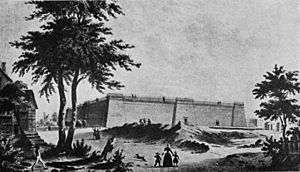
How the Aqueduct Changed New York City
Water first started flowing through the aqueduct on June 22, 1842. It took 22 hours for the water to travel the 41 miles (66 km) to Manhattan using only gravity. Even though only a small number of homes were connected at first, the clean Croton water quickly made a big difference.
People's homes became much cleaner. Wealthy New Yorkers started adding baths and running water to their houses. Public bathing places were also built for everyone to use. The new water system had another interesting effect: the city's wells were used less, so the underground water level rose and flooded many basements. To fix this, the city built many sewers in residential streets. By 1852, 148 miles (238 km) of sewers had been built.
Around this time, a type of cockroach became common and was nicknamed the "Croton bug." People mistakenly thought the aqueduct brought these insects into homes connected to the new water supply.
Even with its large size, the Old Croton Aqueduct couldn't keep up with New York City's rapid growth. So, in 1885, construction began on the New Croton Aqueduct a few miles to the east. The new aqueduct, which was buried much deeper, started working in 1890. It could carry three times more water than the old one. Today, it still provides about 10 percent of New York City's water.
The Croton Receiving Reservoir in Central Park continued to supply drinking water until 1940. That's when it was drained and filled in to create the Great Lawn and Turtle Pond that you can see in Central Park today. The Old Croton Aqueduct itself continued to be used until 1955. In 1987, the northern part of it was reopened to provide water to the town of Ossining.
Old Croton Trail
| Old Croton Trail | |
|---|---|
| Length | 26.2 mi (42.2 km) |
| Location | Westchester County, New York, U.S. |
| Trailheads | Van Cortlandt Park, New York Croton Gorge Park, New York |
| Use | Hiking, Biking, Jogging |
| Difficulty | Easy |
| Season | Year round |
| Sights | Lyndhurst |
| Hazards | Poison ivy |
Today, much of the Old Croton Aqueduct's path is a popular trail called the Old Croton Trail. It stretches for 26.2 miles (42.2 km) through Westchester County. Most of the trail is open to the public for Hiking, biking, and Jogging. There are only a few small sections where the trail goes onto streets.
The trail goes through interesting places like the lawn of Lyndhurst, a historic mansion. It also enters New York City at Van Cortlandt Park and runs through the Bronx.
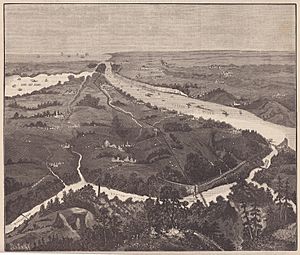
Both the trail and the aqueduct tunnel are part of the Old Croton Aqueduct State Historic Park. This park was created in 1968 and covers the northern 26 miles (42 km) of the aqueduct and the land around it. It's located entirely in Westchester County and is managed by New York State Parks.
The trail runs close to the Metro-North Hudson Line train tracks. This makes it easy to access from many train stations. It also briefly runs next to the Rockefeller State Park Preserve. You can easily find the trail where it crosses Route 9.
What You Can See Along the Trail
As you explore the trail, you can still see parts of the original aqueduct. There are 21 stone "ventilators" (the cone-shaped towers) and three stone "weirs." Weirs were special chambers used to empty the aqueduct for maintenance by sending water to a nearby stream. The entire line could be emptied in just two hours!
You can also visit one "Keeper's House" in Dobbs Ferry. This house was built in 1857 and is the only one of the original four Keeper's Houses that is still on the aqueduct's path and open to the public. Another Keeper's House exists in Ossining, but it was moved and is now privately owned.
A large part of the Old Croton Aqueduct, from the Croton River to Manhattan, was recognized as a National Historic Landmark in 1992. It was also named a National Historic Civil Engineering Landmark in 1975 by the American Society of Civil Engineers.
The inside of the Old Croton Aqueduct has been explored and documented by groups like The LTV Squad, Miru Kim, and historian Steve Duncan.
Gallery
-
"Shutting off the Croton", from Harper's Weekly (November 12, 1881)
-
A weir in Sleepy Hollow, New York. Weir chambers were used to empty the aqueduct for maintenance by sending water to a nearby waterway. The line could be emptied in two hours.
-
Croton Walk, south of Kingsbridge Road, Bronx
-
The 1857 Keeper's House in Dobbs Ferry, New York; it's open to the public.
-
Inside the Old Croton Aqueduct at the weir in Ossining
Images for kids
-
Ventilator No. 16, Irvington, New York (May 2005)



